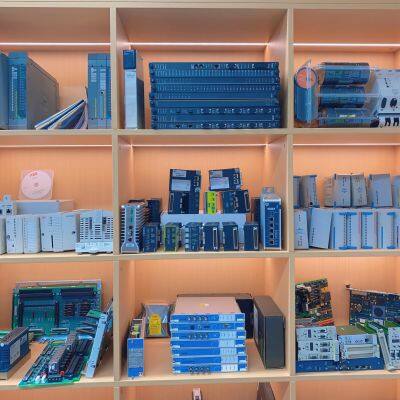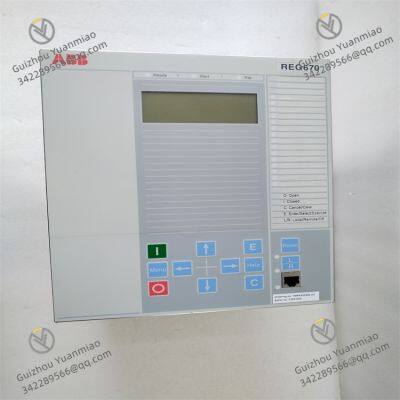Product Description
I. Overview
ABB REG670, as an Intelligent Electronic Device (IED), undertakes extremely crucial protection, monitoring, and control tasks in the field of power systems. It is widely applicable to overhead lines and cables in various networks, from distribution level to the highest voltage level systems, and can operate stably and efficiently. Whether it is a heavily loaded line, a multi-terminal line requiring single-phase, two-phase, or three-phase tripping, REG670 can provide reliable protection. Even for cable feeders connected to generator unit transformers, it can excellently complete the protection work. This device is an important member of the ABB Relion® product series, which, with advanced technology, extensive functions, and high reliability, has been widely used in global power systems. The design of REG670 follows the core values of the IEC 61850 standard, ensuring interoperability with other intelligent devices and future-oriented applicability, helping to build a modern and intelligent power system.

II. Technical Parameters
(1) Electrical Parameters
Operating Frequency: Supports operating frequencies of 50Hz or 60Hz, which can adapt to power system standards in different regions and be widely used globally. It can operate stably both in European regions adopting the 50Hz standard and in North American regions using the 60Hz standard, ensuring the normal operation of the power system.
Voltage Level Adaptability: Can cover a wide range from distribution voltage to high voltage levels, and can be connected to and adapt to power lines of different voltage levels. It can accurately perform protection, monitoring, and control for common 10kV, 35kV distribution lines, as well as 110kV, 220kV, and even higher voltage level transmission lines, meeting the needs of power systems of different scales.
(2) Physical Parameters
Dimension Specifications: The device has a compact and reasonable size design, with specific dimensions to be supplemented. This design enables it to be flexibly installed in various substations or electrical equipment control cabinets with limited space, efficiently exerting its functions without occupying too much space, and facilitating power engineers in system layout and equipment installation.
Installation Methods: Supports two common installation methods: rack mounting and panel mounting, providing users with more installation options. Users can flexibly decide which installation method to adopt according to the actual equipment layout and usage scenarios, enhancing the adaptability and convenience of the device.
(3) Environmental Parameters
Temperature Range: The operating temperature range is -40℃ to +70℃, with extremely strong adaptability to ambient temperature. It can operate stably in extremely cold polar regions, hot desert areas, and plateau areas with drastic temperature differences, ensuring uninterrupted monitoring and protection of the power system, and providing strong guarantee for power supply safety in extreme environments.
Humidity Range: Can work normally in an environment with a relative humidity of 5% - 95% (non-condensing). The interior of the device adopts advanced moisture-proof technology, with key components such as circuit boards treated with moisture-proof coating. At the same time, the device shell is well-sealed, effectively preventing short circuits, corrosion, and other damages to the internal circuits of the device caused by humid air. This enables it to operate reliably in humid coastal areas, rainy southern regions, and indoor substation environments with high humidity, extending the service life of the device.

III. Functional Features
(1) High-Precision Protection Functions
Phase-Segregated Current Differential Protection: Adopts advanced phase-segregated current differential protection technology, which has extremely high sensitivity to high-resistance faults. By accurately comparing parameters such as the amplitude and phase of currents at both ends of the line, it can quickly and accurately detect high-resistance faults in the line. Even when the fault resistance is large, it can promptly send out protection action signals to cut off the faulty line, avoiding the further expansion of the fault. At the same time, this protection function also has reliable phase selection capability, which can accurately determine the phase where the fault occurs, providing an important basis for fault Investigation and repair. It can be applied to complex power networks with up to five line terminals, ensuring the safe and stable operation of the power system.
Distance Protection: Integrates distance protection function, which judges the fault location based on measuring the electrical distance (i.e., impedance) from the fault point to the protection installation location. By real-time monitoring the voltage and current of the line, it calculates the impedance value of the line and compares it with the preset protection setting value. When the impedance value is less than the set operating impedance, the protection action is activated immediately. The distance protection function can reliably protect the entire length of the line under different operating modes and fault types, providing a multi-level protection barrier for the power system.
(2) Flexible Control and Monitoring Functions
Comprehensive Control Functions: Provides comprehensive control functions, which can accurately control circuit breakers, disconnectors, and other equipment in the power system. It supports multiple control modes, including local control, remote control, and automatic control. In the local control mode, operation and maintenance personnel can directly operate through the human-machine interface (HMI) of the device; in the remote control mode, it can receive control commands from the remote monitoring center through the communication network to realize remote operation, improving the convenience and timeliness of operation. At the same time, the device also has automatic control functions, such as automatically completing operations such as closing and tripping of circuit breakers according to preset logic and conditions, realizing the intelligent operation of the power system.
Real-Time Monitoring and Diagnosis: Has powerful real-time monitoring and diagnosis functions, which can collect and analyze the operating parameters of the power system in real time, such as current, voltage, power, frequency, etc. Through the built-in high-performance processor and advanced algorithms, it processes the collected data in real time, timely detects abnormal situations in the system, such as overcurrent, overvoltage, undervoltage, frequency abnormality, etc., and can quickly carry out fault diagnosis and locate the fault point. At the same time, the device is also equipped with an event recording function, which can record various events in the system operation process in detail, including fault events, operation events, etc., providing detailed data support for subsequent fault analysis and system maintenance.
(3) Convenient Configuration and Expansion Functions
Modular Design and Configuration Flexibility: Adopts a modular design concept, allowing users to flexibly configure various functions and parameters of the device according to actual application needs. The device provides a wealth of optional function modules, such as different types of protection function modules, communication modules, input and output modules, etc. Users can select appropriate modules for combination according to the specific situation of the power system and their own needs to achieve personalized configuration. At the same time, the device also supports online configuration and remote configuration. Users can modify and adjust the parameters of the device through the communication network without affecting the normal operation of the device, greatly improving the convenience and flexibility of configuration.
Expandability: Has good expandability, and can be easily integrated with other ABB devices or third-party devices to realize the expansion and upgrade of system functions. For example, by adding communication modules, interconnection and intercommunication with more intelligent devices can be realized; by adding input and output modules, the ability of the device to collect and control external signals can be expanded. When the scale of the power system expands or functional requirements increase, RED670 can easily adapt, providing strong support for the continuous development of the power system.
(4) High Reliability and Stability
Robust Hardware Design: In terms of hardware design, high-quality electronic components are selected and undergo strict quality inspection and screening to ensure that the device is not prone to failures during long-term use. The device shell is made of high-strength materials, with good mechanical protection performance, which can effectively resist external physical impacts such as collisions and vibrations, and protect the internal precision circuits from damage. At the same time, the internal circuit layout of the device is carefully optimized, and advanced electromagnetic compatibility design technology is adopted to reduce signal interference and electromagnetic radiation, improving the stability of the device's operation.
Perfect Software Algorithms and Self-Diagnosis Mechanism: Equipped with advanced software algorithms, which can accurately analyze and process the complex operating status of the power system. The software has self-learning and adaptive capabilities, and can automatically adjust protection and control strategies according to the operating conditions of the power system, improving the intelligence level of the device. In addition, the device also has a perfect self-diagnosis mechanism, which can monitor its own working status in real time. Once a fault is found, it immediately conducts self-diagnosis and sends fault information to the outside through indicator lights, communication interfaces, etc., facilitating operation and maintenance personnel to carry out fault Investigation and repair in a timely manner, ensuring the high-reliability operation of the device.
WOODWARD 9907-1200 Current Pressure Converter
ABB REC670 Intelligent Electronic Device (IED)
WOODWARD MSLC-2 8440-1977 Microprocessor-based Load Control Module
WOODWARD DSLC-2 8440-1978 Digital Synchronizer Load Control Module
ABB REF545KC133AAAA Feeder Protection Terminal
WOODWARD EGCP-2 8406-121 Microprocessor Control Module


ABB REX521BBHGLB01C Feeder Protection Terminal
WOODWARD 8237-1600 High-performance Control Module
ABB REC670 1MRK002814-AB Interval Control Device
ABB REC670 1MRK002814-AC Interval Control Device
ABB REC650 1MRK008514-CB Interval Control Unit
ABB REC650 1MRK008514-AB Interval Control Unit
ABB RED521 1MRK002003-BA Voltage Protection Device
GE IC697CHS750 5-slot Rear-mounted I/O Rack Module
ABB REL551 1MRK002480-AE Voltage Protection Device
ABB REF615C_E HCFFAEAGANB2BAA11E Feeder Protection Measurement and Control Device
ABB REF615C_E HCFFAEAGABC2BAA11E Feeder Protection Measurement and Control Device
ABB 1MRK002133-ABr02 Analog Digital Module
ABB UNITROL1020 Excitation Systems
ABB UNS0119A-Z,V1 3BHE030579R0001 Excitation Systems
GE VMIVME-017807-414001 350-0001007807-414001 D Single-Board Computer
GE VME7865RC V7865-23003 350-9300007865-230003 M Single-Board Computer
GE IS210BPPCH1AEC Power Supply Module
GE IS210BPPCH1AD Printed Circuit Board
 yezi
Hi there! Welcome to my shop. Let me know if you have any questions.
yezi
Hi there! Welcome to my shop. Let me know if you have any questions.




